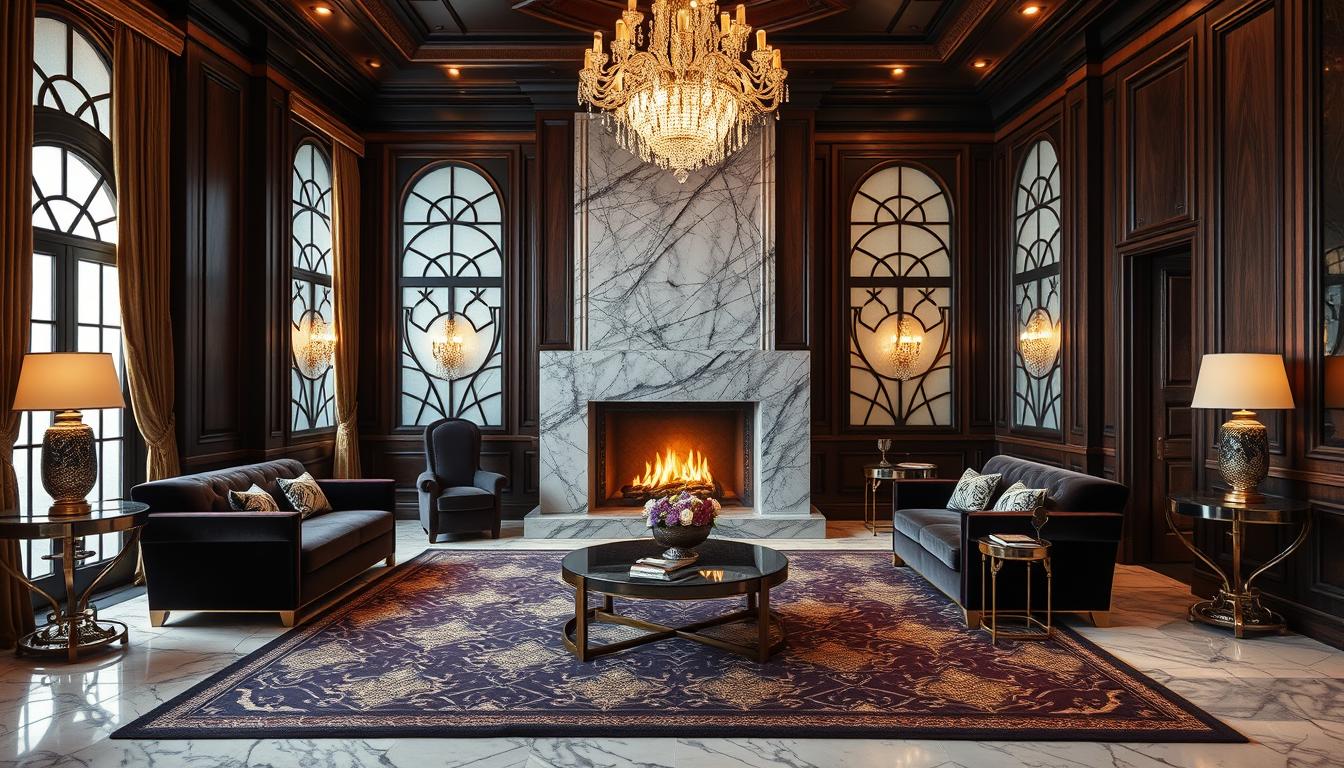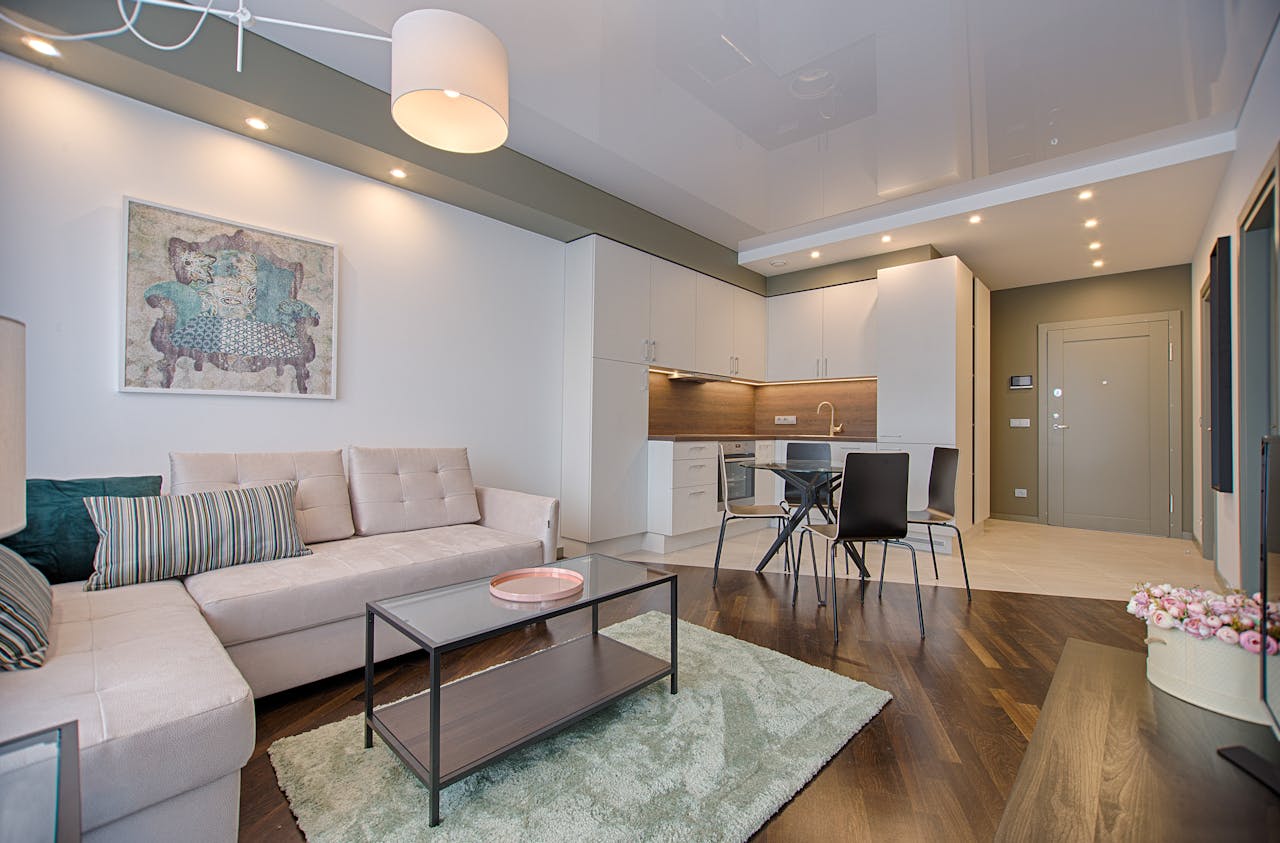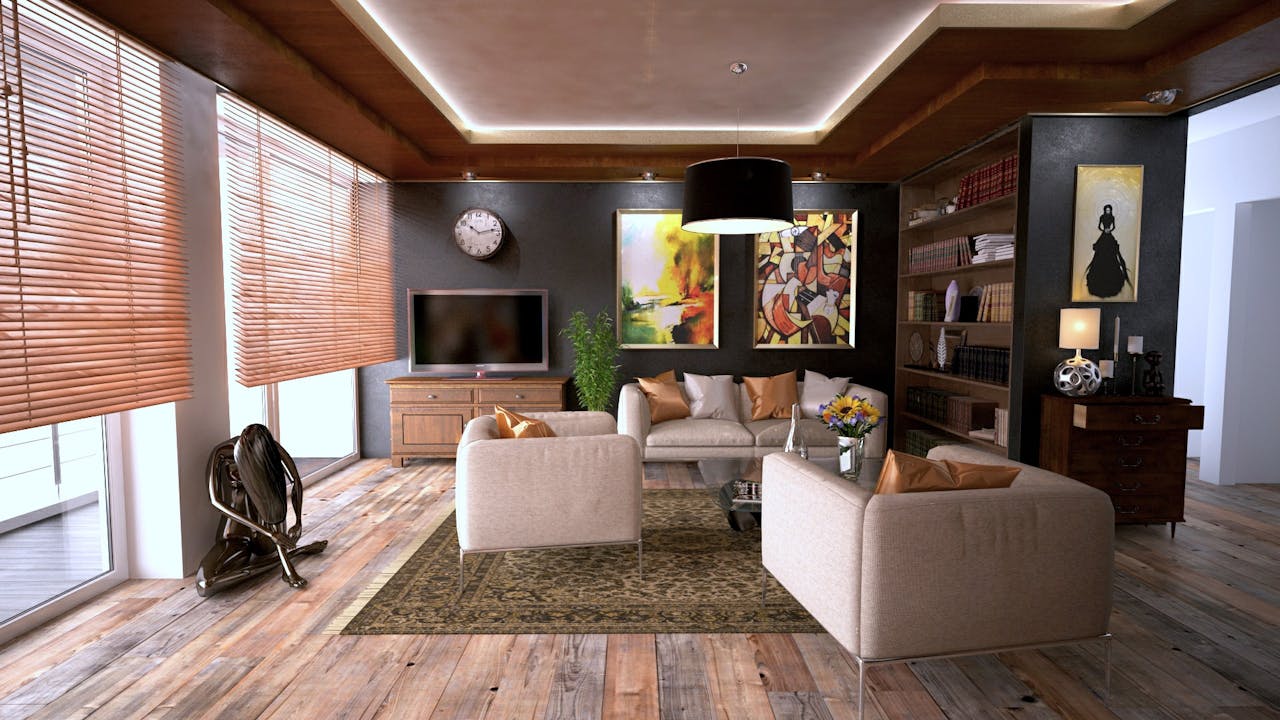Did you know that Art Deco, born in France, became a global phenomenon in the early 20th century? It influenced everything from architecture to jewelry. This style is known for its geometric shapes, stylized curves, and luxurious materials. It still charms designers and homeowners with its glamour and sophistication.
We’ll dive into how luxury interior design uses Art Deco’s essence. It adds opulence to today’s spaces. Our guide will highlight the style’s key elements. These include bold colors, metallic accents, atmospheric lighting, and ornate patterns.
Key Takeaways
- Understanding the history and evolution of Art Deco
- Identifying key elements that define the Art Deco style
- Applying Art Deco principles to modern luxury interior design
- Tips for incorporating Art Deco into your home decor
- Common mistakes to avoid when designing with Art Deco
Understanding the Essence of Art Deco
Exploring Art Deco reveals a rich history and style from the 1920s. This movement, starting in the early 20th century, is known for its luxury, geometric shapes, and vibrant colors.
Historical Context of the 1920s
The Art Deco movement began at the International Exhibition of Modern Decorative and Industrial Arts in Paris in 1925. This event was a turning point in interior design history. It brought designers and artists from all over to showcase their work.
The 1920s were a time of change and modernity. People were embracing new technologies and cultural influences. Art Deco design became a symbol of glamour and sophistication, reflecting the era’s love for luxury and progress.
Key Characteristics of Art Deco Style
What makes Art Deco unique? It’s all about geometric patterns, luxury materials, and bold colors. You’ll find chevrons, zigzags, and sunburst motifs, along with materials like marble, velvet, and chrome. These elements create a striking and opulent look that’s truly Art Deco.
In vintage interior design, Art Deco is about luxury and glamour. It uses bold colors, metallic accents, and eye-catching furniture. By adding these touches, homeowners can make their space feel like a piece of the 1920’s inspired interiors that Art Deco is known for.
Iconic Colors and Materials of the Era
Exploring 1920s Art Deco interior design, we see bold colors and luxurious materials. These elements bring sophistication to any space.
The Art Deco era was all about luxury. This is seen in its color and material choices. The style features deep yellows, reds, greens, blues, and pinks. These colors are often mixed in bold ways.
Popular Color Palettes
Art Deco’s color schemes are key to its style. Some iconic colors include:
- Rich jewel tones like emerald green and sapphire blue
- Metallic colors such as gold, silver, and chrome
- Deep, bold reds and oranges
- Soft pastels, used to add elegance
These colors were mixed to create stunning effects. For example, deep blues with metallic golds or rich greens with bold reds.
| Color Palette | Description | Example Use |
|---|---|---|
| Jewel Tones | Rich emerald greens and sapphire blues | Accent walls, luxurious fabrics |
| Metallic | Gold, silver, and chrome | Lighting fixtures, decorative accents |
| Bold Contrasts | Deep reds and oranges against neutral backgrounds | Statement furniture, artwork |
Essential Materials for Authentic Design
Art Deco design is known for its luxurious materials. Some key materials include:
- Marble, for its elegance and sophistication
- Velvet and silk, for their luxurious feel and look
- Chrome and metallic finishes, for a modern touch
- Exotic woods, for their unique grain and luxurious feel
These materials were used in creative ways to add opulence. For example, marble might be used for a statement fireplace. Velvet and silk were used for upholstery and drapery.
Using these iconic colors and materials can create a space that feels like the Art Deco era. Whether you’re aiming for a Gatsby-style decor or just want to add some roaring twenties flair, these elements will help you achieve an authentic look.
Furniture Styles That Define the Decade
The 1920s was a time of big change in interior design. Art Deco furniture became popular, showing luxury and modernity. It had sleek lines and rich materials, making it the style of the 1920s.
Art Deco furniture used many materials, like exotic woods, fancy fabrics, and metals. This mix gave it a rich, luxurious feel.
Signature Furniture Pieces
Some of the most famous Art Deco furniture pieces include:
- Geometric-shaped chairs and tables: These had bold shapes and were made from materials like ebony and ivory.
- Luxurious upholstered furniture: Sofas and armchairs were covered in velvet and silk, adding to the room’s luxury.
- Console tables and sideboards: Decorated with detailed inlays and metals, they stood out in any room.
How to Choose Art Deco Furniture
When picking Art Deco furniture, think about these things:
| Characteristic | Description | Example |
|---|---|---|
| Material | Luxurious materials like wood, leather, and metal | Ebony and ivory inlays |
| Shape | Bold, geometric shapes | Geometric-shaped chairs and tables |
| Upholstery | Luxurious fabrics like velvet and silk | Velvet sofas and armchairs |
By focusing on these key elements, you can make your home look authentic Art Deco. It will be stylish and elegant.
Architectural Elements of 1920’s Design
The 1920s Art Deco architecture is known for its geometric shapes and patterns. It also emphasizes symmetry. This style brought luxury and glamour to homes. Homeowners can bring this style into their homes by using certain architectural elements.
Geometric Shapes and Patterns
Geometric shapes and patterns are key in Art Deco design. You’ll see chevrons, zigzags, and sunburst patterns a lot. These add a modern and dynamic feel to any room.
Some common geometric patterns include:
- Chevron patterns, often seen in flooring and wall designs
- Zigzag motifs, commonly used in decorative accents and textiles
- Sunburst patterns, typically found in lighting fixtures and metalwork
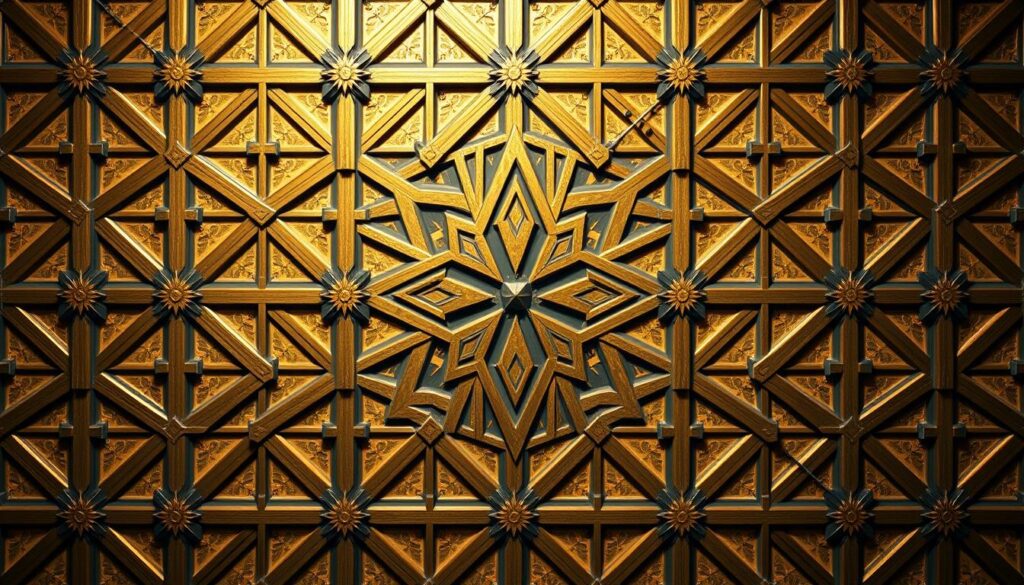
The Role of Symmetry in Design
Symmetry is vital in Art Deco design. It brings balance and harmony to spaces. Symmetrical designs use matching furniture and decorations to create a luxurious feel.
| Design Element | Symmetrical Application | Asymmetrical Alternative |
|---|---|---|
| Furniture | Pairing identical chairs or tables | Using varied shapes or sizes |
| Decorative Accents | Matching vases or sculptures on either side of a room | Placing unique or differently sized items |
| Layout | Mirroring elements around a central axis | Creating a more free-form or eclectic arrangement |
By using these architectural elements, you can create stunning art deco decor. Whether it’s through geometric patterns or symmetrical designs, you can bring the 1920s Art Deco style into your home.
Art Deco Lighting Solutions
Art Deco lighting is key in luxury interior design. It uses geometric shapes and luxurious materials.
Lighting in the Art Deco style is often dramatic and ornate. It uses materials like chrome and glass. These elements light up the room and add to its beauty.
Types of Lighting Fixtures
Art Deco lighting includes many fixtures. Each one adds to the luxury of a space. Here are some iconic types:
- Chandeliers: Often the room’s centerpiece, Art Deco chandeliers are grand. They have intricate details and luxurious materials.
- Sconces: Wall-mounted sconces offer both ambient and task lighting. Their geometric shapes make them decorative.
- Table Lamps: With ornate bases and luxurious shades, table lamps are both functional and decorative.
Tips for Incorporating Lighting
To add Art Deco lighting to your space, follow these tips:
| Tip | Description |
|---|---|
| Layer Lighting | Use different light sources for a layered effect. This adds depth and visual interest. |
| Choose Luxurious Materials | Choose fixtures with materials like chrome, glass, and crystal. They add luxury. |
| Consider Scale | Make sure your lighting fits the room and furniture. This keeps the aesthetic balanced. |
By picking and placing Art Deco lighting carefully, you can create a space full of glamour. It captures the essence of Gatsby style decor perfectly.
Fabrics and Textiles Embracing the Style
The 1920’s Art Deco style shines through its use of luxurious fabrics and textiles. This era loved drama and luxury, seen in the rich materials used for furniture and decor.
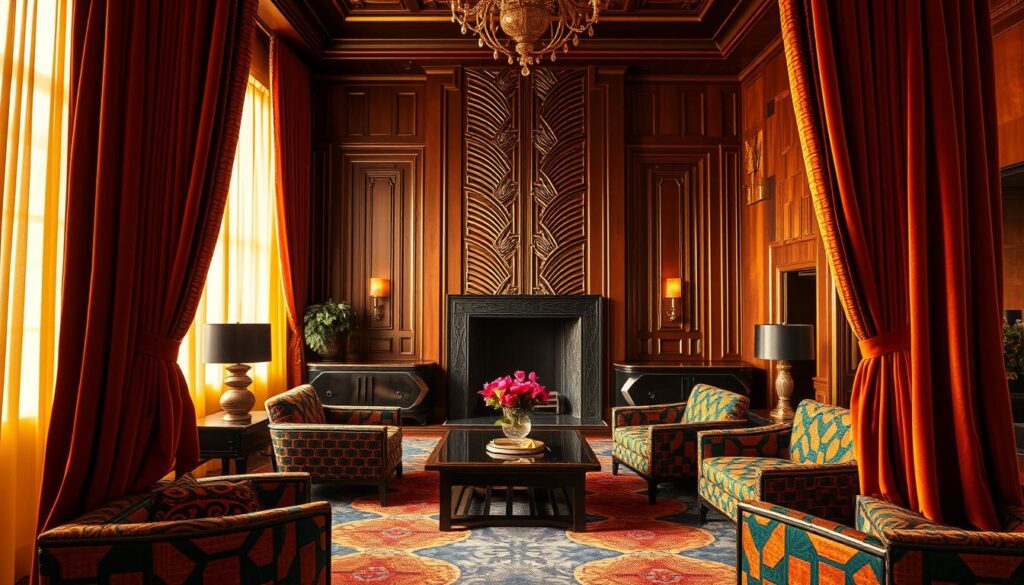
Common Fabrics Used in Art Deco
Art Deco is known for its high-quality fabrics like velvet, silk, and leather. These materials were used in eye-catching pieces like plush armchairs and lavish drapes. They added depth and interest to any room.
Velvet was a top choice for upholstery, offering a soft, luxurious feel. Silk was favored for its shine and elegant drape, often used in curtains or wall hangings. These added to the room’s ambiance.
Ways to Layer Textiles Effectively
Layering textiles is key to an authentic Art Deco look. Mixing different textures and patterns creates a rich, inviting atmosphere. Start with a base layer, like a plush area rug or velvet sofa, and add layers with throw pillows, blankets, and drapes.
To avoid overwhelming the space, balance bold patterns with solid colors. Mix different textures thoughtfully. For example, a smooth leather armchair paired with a chunky woven throw blanket adds depth and interest.
Embracing the luxurious fabrics and textiles of the 1920’s Art Deco style brings glamour to your home. Whether through statement furniture or layered drapery, the right textiles can turn a space into a vintage interior design masterpiece.
Decorative Accents and Accessories
Decorative accents and accessories are key to Art Deco’s luxury and style. They add glamour and help create a cohesive, luxurious space.
Iconic Art Deco Accessories
Art Deco accessories include iconic pieces like geometric-shaped vases and metallic decorative objects. Luxurious throw pillows are also essential. These items capture the essence of Art Deco style.
- Geometric-shaped vases: These vases, often made from materials like glass or metal, add elegance and sophistication.
- Metallic decorative objects: Items made from chrome, silver, or gold add a luxurious feel to the space.
- Luxurious throw pillows: With intricate designs and opulent fabrics, these pillows can instantly elevate the decor of a room.
How to Use Accessories to Enhance Spaces
To effectively use Art Deco accessories, consider these tips:
- Balance is key: Ensure that the accessories complement the existing decor without overwhelming it.
- Mix and match: Combine different textures and materials to add depth to the space.
- Focus on statement pieces: Identify a few statement accessories that can become the focal points of the room.
By thoughtfully incorporating these decorative accents and accessories, you can achieve a genuine Art Deco look. This look exudes luxury and sophistication.
Integrating Art into Your Interior Design
Adding art to vintage interior design is key to a beautiful and cohesive space. Art Deco brings glamour and sophistication with geometric abstract art, sculptures, and prints. These elements can transform a room.
Popular Art Forms of the 1920s
In the 1920s, geometric abstract art was all the rage. It featured bold shapes and metallics. Sculptures and figurines, often in bronze and ivory, were also sought after. Prints and posters with stylized motifs added visual interest.
These art forms are known for:
- Geometric shapes and metallic materials
- Stylized motifs and patterns
- Use of luxurious materials like bronze and ivory
Elsie de Wolfe, a famous interior designer, said, “The art of decorating is not about creating a dull, monotonous space, but about crafting a vibrant, eclectic atmosphere that reflects one’s personality.” This captures the essence of Art Deco, embracing boldness and elegance.
“The art of decorating is not about creating a dull, monotonous space, but about crafting a vibrant, eclectic atmosphere that reflects one’s personality.”
How to Display Art in Art Deco Spaces
Displaying art in Art Deco spaces needs careful thought. Here are some tips:
- Use metallic frames and mounts to add a touch of luxury.
- Group art pieces together to create a visually appealing display.
- Consider the scale of the art in relation to the room and furniture.
| Art Form | Display Tips |
|---|---|
| Geometric Abstract Art | Use bold frames and place in a prominent location. |
| Sculptures | Display on decorative pedestals or shelves. |
| Prints and Posters | Group together in a collage or use metallic frames. |
When adding art to your 1920’s inspired interiors, balance vintage and contemporary. This creates a unique and captivating space that captures the glamour of the Art Deco era.
Outdoor Spaces and Gardens
The Art Deco style isn’t just for indoors. It can also transform outdoor spaces and gardens. This creates a stylish look that ties your whole home together.
To design an Art Deco outdoor area, think about using geometric patterns, luxurious materials, and bold colors. This style is all about making a bold statement. So, feel free to get creative with your choices.
Gardens and Landscaping Ideas
Art Deco gardens feature symmetry, geometric shapes, and ornate details. To create an Art Deco garden, consider these elements:
- Geometric patterns in your landscaping, such as chevron or herringbone designs
- Luxurious materials like marble or granite for pathways and statues
- Bold, vibrant colors in your plant choices and outdoor decor
- Ornate details like metalwork or glass accents
For more inspiration, check out 1920s conservatory ideas on Pinterest. They show how Art Deco can be used in your outdoor space.
Furniture and Decor for Outdoor Areas
When picking outdoor furniture and decor, focus on a few key elements for an Art Deco look:
- Luxurious Materials: Choose furniture made from high-quality, weather-resistant materials like wrought iron or recycled metal.
- Geometric Shapes: Opt for furniture with geometric shapes, such as circles, triangles, or chevrons, to add visual interest.
- Bold Colors: Incorporate bold, vibrant colors through cushions, umbrellas, or decorative accents to add a pop of color.
- Ornate Details: Look for pieces with ornate details, like inlays or etchings, to add an extra layer of sophistication.
By using these elements, you can make an outdoor space that’s not just beautiful. It also captures the luxury and glamour of the Art Deco style.
Sustaining Art Deco Design Today
Art Deco’s geometric patterns, metallic materials, and bold colors are making a comeback in modern interiors. This style, born in the 1920s, still shapes luxury interior design with its lavish look.
When we mix 1920’s Art Deco interior design with today’s trends, it brings sophistication and glamour. The secret to keeping Art Deco alive today is to mix its classic charm with modern touches.
Modern Interpretations of Art Deco
Modern Art Deco updates its timeless elements for today’s tastes. Here’s how:
- Use bold, geometric patterns in fresh ways, like on accent walls or in statement furniture.
- Add luxury with metallics like chrome, silver, and gold.
- Choose a color scheme that mixes Art Deco’s bold hues with softer tones for balance.
Balancing Vintage and Contemporary Elements
To mix vintage and modern, try these tips:
- Match vintage Art Deco pieces with modern furniture for a striking contrast.
- Update classic Art Deco patterns with modern materials and textures.
- Combine vintage colors with modern neutrals for a cohesive color scheme.
By combining old and new, we craft spaces that are stylish, rich in history, and full of character. This fusion of vintage interior design and modern elements is key to keeping Art Deco alive today.
Bringing It All Together
Creating a cohesive Art Deco interior needs careful planning and attention to detail. To achieve a stylish and inviting atmosphere, we must consider the key elements of Art Deco design. These include luxurious materials, geometric shapes, and iconic colors.
Tips for a Unified Look
To create a unified Art Deco look, use a consistent color palette. Incorporate Gatsby style decor and balance vintage and contemporary elements. This mix of old and new adds depth and visual interest to your 1920’s inspired interiors.
Final Considerations
As we bring our Art Deco design together, focus on art deco decor that reflects the glamour and sophistication of the era. Incorporate luxurious materials, statement lighting fixtures, and ornate accessories. This will create a truly immersive Art Deco experience.

